Soil Erosion Assessment Using the Intensity of Erosion and Outflow Model by Estimating Sediment Yield: Case Study in River Basins with Different Characteristics from Cluj County, Romania
Abstract
1. Introduction
2. Materials and Methods
2.1. Study Area
2.2. Methodological Approach and IntErO Model
2.3. Data Acquisition, Physio-Geographical and Climate Characteristics
3. Results
3.1. RUSLE Erosion Modeling in Cluj County
3.2. IntErO Implementation on the Three Selected Prototype River Basins in Cluj County
4. Discussion
5. Conclusions
Author Contributions
Funding
Institutional Review Board Statement
Informed Consent Statement
Data Availability Statement
Acknowledgments
Conflicts of Interest
References
- Mohammadi, M.; Khaledi Darvishan, A.K.; Spalevic, V.; Dudic, B.; Billi, P. Analysis of the Impact of Land Use Changes on Soil Erosion Intensity and Sediment Yield Using the IntErO Model in the Talar Watershed of Iran. Water 2021, 13, 881. [Google Scholar] [CrossRef]
- Eswaran, H.; Lal, R.; Reich, P.F. Land degradation: An overview. In Responses to Land Degradation; Oxford Press: New Delhi, India, 2001; pp. 20–35. [Google Scholar]
- Zabihi, M.; Mirchooli, F.; Motevalli, A.; Khaledi Darvishan, A.; Pourghasemi, H.R.; Zakeri, M.A.; Sadighi, F. Spatial modelling of gully erosion in Mazandaran Province, northern Iran. Catena 2018, 161, 1–13. [Google Scholar] [CrossRef]
- Novara, A.; Pisciotta, A.; Minacapilli, M.; Maltese, A.; Capodici, F.; Cerdà, A.; Gristina, L. The impact of soil erosion on soil fertility and vine vigor. A multidisciplinary approach based on field, laboratory and remote sensing approaches. Sci. Total Environ. 2018, 622, 474–480. [Google Scholar] [CrossRef] [PubMed]
- Chalise, D.; Kumar, L.; Spalevic, V.; Skataric, G. Estimation of Sediment Yield and Maximum Outflow Using the IntErO Model in the Sarada River Basin of Nepal. Water 2019, 11, 952. [Google Scholar] [CrossRef]
- Verheijen, F.G.A.; Jones, R.J.A.; Rickson, R.J.; Smith, C.J. Tolerable versus actual soil erosion rates in Europe. Earth Sci. Rev. 2009, 94, 23–38. [Google Scholar] [CrossRef]
- Hazbavi, Z.; Sadeghi, S.H.; Gholamalifard, M. Dynamic analysis of soil erosion-based watershed health. Geogr. Environ. Sustain. 2019, 12, 43–59. [Google Scholar] [CrossRef]
- Costea, A.; Bilasco, S.; Irimus, I.-A.; Rosca, S.; Vescan, I.; Fodorean, I.; Sestras, P. Evaluation of the Risk Induced by Soil Erosion on Land Use. Case Study: Guruslău Depression. Sustainability 2022, 14, 652. [Google Scholar] [CrossRef]
- Spalevic, V.; Barovic, G.; Vujacic, D.; Curovic, M.; Behzadfar, M.; Djurovic, N.; Dudic, B.; Billi, P. The Impact of Land Use Changes on Soil Erosion in the River Basin of Miocki Potok, Montenegro. Water 2020, 12, 2973. [Google Scholar] [CrossRef]
- Dragicevic, N.; Karleusa, B.; Ozanic, N. Different Approaches to Estimation of Drainage Density and Their Effect on the Erosion Potential Method. Water 2019, 11, 593. [Google Scholar] [CrossRef]
- Batista, P.V.G.; Silva, M.L.N.; Silva, B.P.C.; Curi, N.; Bueno, I.T.; Júnior, F.W.A.; Davies, J.; Quinton, J. Modelling spatially distributed soil losses and sediment yield in the upper Grande River Basin-Brazil. Catena 2017, 157, 139–150. [Google Scholar] [CrossRef]
- Rodrigo-Comino, J.; Keesstra, S.; Cerdà, A. Soil Erosion as an Environmental Concern in Vineyards: The Case Study of Celler del Roure, Eastern Spain, by Means of Rainfall Simulation Experiments. Beverages 2018, 4, 31. [Google Scholar] [CrossRef]
- Rodrigo-Comino, J.; Taguas, E.; Seeger, M.; Ries, J.B. Quantification of soil and water losses in an extensive olive orchard catchment in Southern Spain. J. Hydrol. 2018, 556, 749–758. [Google Scholar] [CrossRef]
- Feng, T.; Wei, W.; Chen, L.; Rodrigo-Comino, J.; Die, C.; Feng, X.; Ren, K.; Brevik, E.C.; Yu, Y. Assessment of the impact of different vegetation patterns on soil erosion processes on semiarid loess slopes. Earth Surf. Process. Landf. 2018, 43, 1860–1870. [Google Scholar] [CrossRef]
- Wang, W.; Shao, Q.; Yang, T.; Peng, S.; Xing, W.; Sun, F.; Luo, Y. Quantitative assessment of the impact of climate variability and human activities on runoff changes: A case study in four catchments of the Haihe River basin, China. Hydrol. Processes 2013, 27, 1158–1174. [Google Scholar] [CrossRef]
- Ghanbarian, B.; Sahimi, M.; Daigle, H. Modeling relative permeability of water in soil: Application of effective-medium approximation and percolation theory. Water Resour. Res. 2016, 52, 5025–5040. [Google Scholar] [CrossRef]
- Gocić, M.; Dragićević, S.; Radivojević, A.; Martić Bursać, N.; Stričević, L.; Đorđević, M. Changes in Soil Erosion Intensity Caused by Land Use and Demographic Changes in the Jablanica River Basin, Serbia. Agriculture 2020, 10, 345. [Google Scholar] [CrossRef]
- Vaezi, A.R.; Abbasi, M.; Bussi, G.; Keesstra, S. Modeling sediment yield in semi-arid pasture micro-catchments, NW Iran. Land Degrad. Dev. 2017, 28, 1274–1286. [Google Scholar] [CrossRef]
- Jiang, N.; Yao, F.; Liu, T.; Chen, Z.; Hu, C.; Geng, X. Estimating the Soil Erosion Response to Land-Use Change Using GIS-Based RUSLE and Remote Sensing: A Case Study of Heilongjiang Province, China. Sustainability 2023, 15, 8004. [Google Scholar] [CrossRef]
- Thomas, J.; Joseph, S.; Thrivikramji, K. Assessment of soil erosion in a tropical mountain river basin of the southern Western Ghats, India using RUSLE and GIS. Geosci. Front. 2018, 9, 893–906. [Google Scholar] [CrossRef]
- Jain, M.K.; Das, D. Estimation of sediment yield and areas of soil erosion and deposition for watershed prioritization using GIS and remote sensing. Water Resour. Manag. 2010, 24, 2091–2112. [Google Scholar] [CrossRef]
- Spalevic, V.; Lakicevic, M.; Radanovic, D.; Billi, P.; Barovic, G.; Vujacic, D.; Sestras, P.; Darvishan, A.K. Ecological-Economic (Eco-Eco) Modelling in the River Basins of Mountainous Regions: Impact of Land Cover Changes on Sediment Yield in the Velicka Rijeka, Montenegro. Not. Bot. Horti Agrobot. Cluj-Napoca 2017, 45, 602–610. [Google Scholar] [CrossRef]
- Ghosh, A.; Rakshit, S.; Tikle, S.; Das, S.; Chatterjee, U.; Pande, C.B.; Alataway, A.; Al-Othman, A.A.; Dewidar, A.Z.; Mattar, M.A. Integration of GIS and Remote Sensing with RUSLE Model for Estimation of Soil Erosion. Land 2023, 12, 116. [Google Scholar] [CrossRef]
- Van Eck, C.M.; Nunes, J.P.; Vieira, D.C.; Keesstra, S.; Keizer, J.J. Physically-Based Modelling of the Post-Fire Runoff Response of a Forest Catchment in Central Portugal: Using Field versus Remote Sensing Based Estimates of Vegetation Recovery. Land Degrad. Dev. 2016, 27, 1535–1544. [Google Scholar] [CrossRef]
- Efthimiou, N.; Lykoudi, E.; Panagoulia, D.; Karavitis, C. Assessment of soil susceptibility to erosion using the EPM and RUSLE Models: The case of Venetikos River Catchment. Glob. NEST J. 2016, 18, 164–179. [Google Scholar]
- Lazzari, M.; Gioia, D.; Piccarreta, M.; Danese, M.; Lanorte, A. Sediment yield and erosion rate estimation in the mountain catchments of the Camastra artificial reservoir (Southern Italy): A comparison between different empirical methods. Catena 2015, 127, 323–339. [Google Scholar] [CrossRef]
- Parteli, E.J.; Da Silva, L.R.; Andrade, J.S., Jr. Self-organized percolation in multi-layered structures. J. Stat. Mech. Theory Exp. 2010, 2010, P03026. [Google Scholar] [CrossRef][Green Version]
- Renard, K.G.; Foster, G.R.; Weesies, G.A.; Porter, J.P. RUSLE: Revised universal soil loss equation. J. Soil Water Conserv. 1991, 46, 30–33. [Google Scholar]
- Zhao, G.; Kondolf, G.M.; Mu, X.; Han, M.; He, Z.; Rubin, Z.; Wang, F.; Gao, P.; Sun, W. Sediment yield reduction associated with land use changes and check dams in a catchment of the Loess Plateau, China. Catena 2017, 148, 126–137. [Google Scholar] [CrossRef]
- Kisic, I.; Basic, F.; Nestroy, O.; Sabolic, M. Global Change-Challenges for soil management, Advances in Geoecology. In Soil Erosion under Different Tillage and Cropping Systems in Central Croatia; Catena Verlag GMBH: Reiskirchen, Germany, 2010; pp. 141–150. [Google Scholar]
- Glavan, M.; Milicic, V.; Pintar, M. Finding options to improve catchment water quality Lessons learned from historical land use situations in a Mediterranean catchment in Slovenia. Ecol. Model. 2013, 261, 58–73. [Google Scholar] [CrossRef]
- Volk, M.; Liersch, S.; Schmidt, G. Towards the implementation of the European Water Framework Directive? Lessons learned from water quality simulations in an agricultural watershed. Land Use Policy 2009, 26, 580–588. [Google Scholar] [CrossRef]
- Bilașco, Ș.; Roșca, S.; Vescan, I.; Fodorean, I.; Dohotar, V.; Sestras, P. A GIS-Based Spatial Analysis Model Approach for Identification of Optimal Hydrotechnical Solutions for Gully Erosion Stabilization. Case Study. Appl. Sci. 2021, 11, 4847. [Google Scholar] [CrossRef]
- Serbaji, M.M.; Bouaziz, M.; Weslati, O. Soil Water Erosion Modeling in Tunisia Using RUSLE and GIS Integrated Approaches and Geospatial Data. Land 2023, 12, 548. [Google Scholar] [CrossRef]
- Sestras, P.; Bilașco, Ș.; Roșca, S.; Veres, I.; Ilies, N.; Hysa, A.; Spalević, V.; Cîmpeanu, S.M. Multi-Instrumental Approach to Slope Failure Monitoring in a Landslide Susceptible Newly Built-Up Area: Topo-Geodetic Survey, UAV 3D Modelling and Ground-Penetrating Radar. Remote Sens. 2022, 14, 5822. [Google Scholar] [CrossRef]
- Bilaşco, Ş.; Roşca, S.; Păcurar, I.; Moldovan, N.; Boţ, A.; Negrușier, C.; Sestras, P.; Bondrea, M.; Naș, S. Identification of Land Suitability for Agricultural Use by Applying Morphometric and Risk Parameters Based on GIS Spatial Analysis. Not. Bot. Horti Agrobo. 2016, 44, 302–312. [Google Scholar] [CrossRef]
- Kerekes, A.H.; Poszet, S.L.; Andrea, G.Á.L. Landslide susceptibility assessment using the maximum entropy model in a sector of the Cluj–Napoca Municipality, Romania. Rev. Geomorfol. 2018, 20, 130–146. [Google Scholar] [CrossRef]
- Gavrilovic, S. A method for estimating of the average annual quantity of sediments according to the potency of erosion. Bull. Fac. For. 1962, 26, 151–168. [Google Scholar]
- Gavrilovic, S. Engineering of Torrential Flows and Erosion; Izgradnja: Belgrade, Serbia, 1972; 272p. [Google Scholar]
- Spalevic, V. Application of Computer-Graphic Methods in the Studies of Draining Out and Intensities of Ground Erosion in the Berane Valley. Master’s Thesis, Faculty of Agriculture of the University of Belgrade, Belgrade, Serbia, 1999; p. 135. [Google Scholar]
- Spalevic, V.; Dlabac, A.; Spalevic, B.; Fustic, B.; Popovic, V. Application of computer-Graphic methods in the research of runoff and intensity of ground erosion-I program “River basins”. Agric. For. 2000, 46, 19–36. [Google Scholar]
- Yang, L.; Meng, X.; Zhang, X. SRTM DEM and its application advances. Int. J. Remote Sens. 2011, 32, 3875–3896. [Google Scholar] [CrossRef]
- Duscher, K.; Günther, A.; Richts, A.; Clos, P.; Philipp, U.; Struckmeier, W. The GIS layers of the” International Hydrogeological Map of Europe 1: 1,500,000” in a vector format. Hydrogeol. J. 2015, 23, 1867. [Google Scholar] [CrossRef]
- Martínez-Fernández, J.; Ruiz-Benito, P.; Bonet, A.; Gómez, C. Methodological variations in the production of CORINE land cover and consequences for long-term land cover change studies. The case of Spain. Int. J. Remote Sens. 2019, 40, 8914–8932. [Google Scholar] [CrossRef]
- Hysa, A.; Spalevic, V.; Dudic, B.; Roșca, S.; Kuriqi, A.; Bilașco, Ș.; Sestras, P. Utilizing the Available Open-Source Remotely Sensed Data in Assessing the Wildfire Ignition and Spread Capacities of Vegetated Surfaces in Romania. Remote Sens. 2021, 13, 2737. [Google Scholar] [CrossRef]
- Greiner, L.; Kellera, A.; Grêt-Regameyb, A.; Papritzc, A. Soil function assessment: Review of methods for quantifying the contributions of soils to ecosystem services. Land Use Policy 2017, 69, 224–237. [Google Scholar] [CrossRef]
- Parsipour, H.; Popovic, S.; Behzadfar, M.; Skataric, G.; Spalevic, V. Cities expansion and land use changes of agricultural and garden lands in peri-urban villages (case study: Bojnurd). Agric. For. 2019, 65, 173–187. [Google Scholar] [CrossRef]
- Bilașco, Ș.; Hognogi, G.-G.; Roșca, S.; Pop, A.-M.; Iuliu, V.; Fodorean, I.; Marian-Potra, A.-C.; Sestras, P. Flash Flood Risk Assessment and Mitigation in Digital-Era Governance Using Unmanned Aerial Vehicle and GIS Spatial Analyses Case Study: Small River Basins. Remote Sens. 2022, 14, 2481. [Google Scholar] [CrossRef]
- Benavidez, R.; Jackson, B.; Maxwell, D.; Norton, K. A review of the (Revised) Universal Soil Loss Equation ((R) USLE): With a view to increasing its global applicability and improving soil loss estimates. Hydrol. Earth Syst. Sci. 2018, 22, 6059–6086. [Google Scholar] [CrossRef]
- Kostadinov, S.; Braunović, S.; Dragićević, S.; Zlatić, M.; Dragović, N.; Rakonjac, N. Effects of Erosion Control Works: Case Study-Grdelica Gorge, the South Morava River (Serbia). Water 2018, 10, 1094. [Google Scholar] [CrossRef]
- Khaleghi, M.R. The influence of deforestation and anthropogenic activities on runoff generation. J. For. Sci. 2017, 63, 245–253. [Google Scholar] [CrossRef]
- Myronidis, D.; Ioannou, K.; Sapountzis, S.; Fotakis, D. Development of a sustainable plan to combat erosion for an island of the Mediterranean region. Fresenius Environ. Bull. 2010, 19, 1694–1702. [Google Scholar]
- Dragicevic, N.; Karleusa, B.; Ozanic, N. Modification of erosion potential method using climate and land cover parameters. Nat. Hazards Risk 2018, 9, 1085–1105. [Google Scholar] [CrossRef]
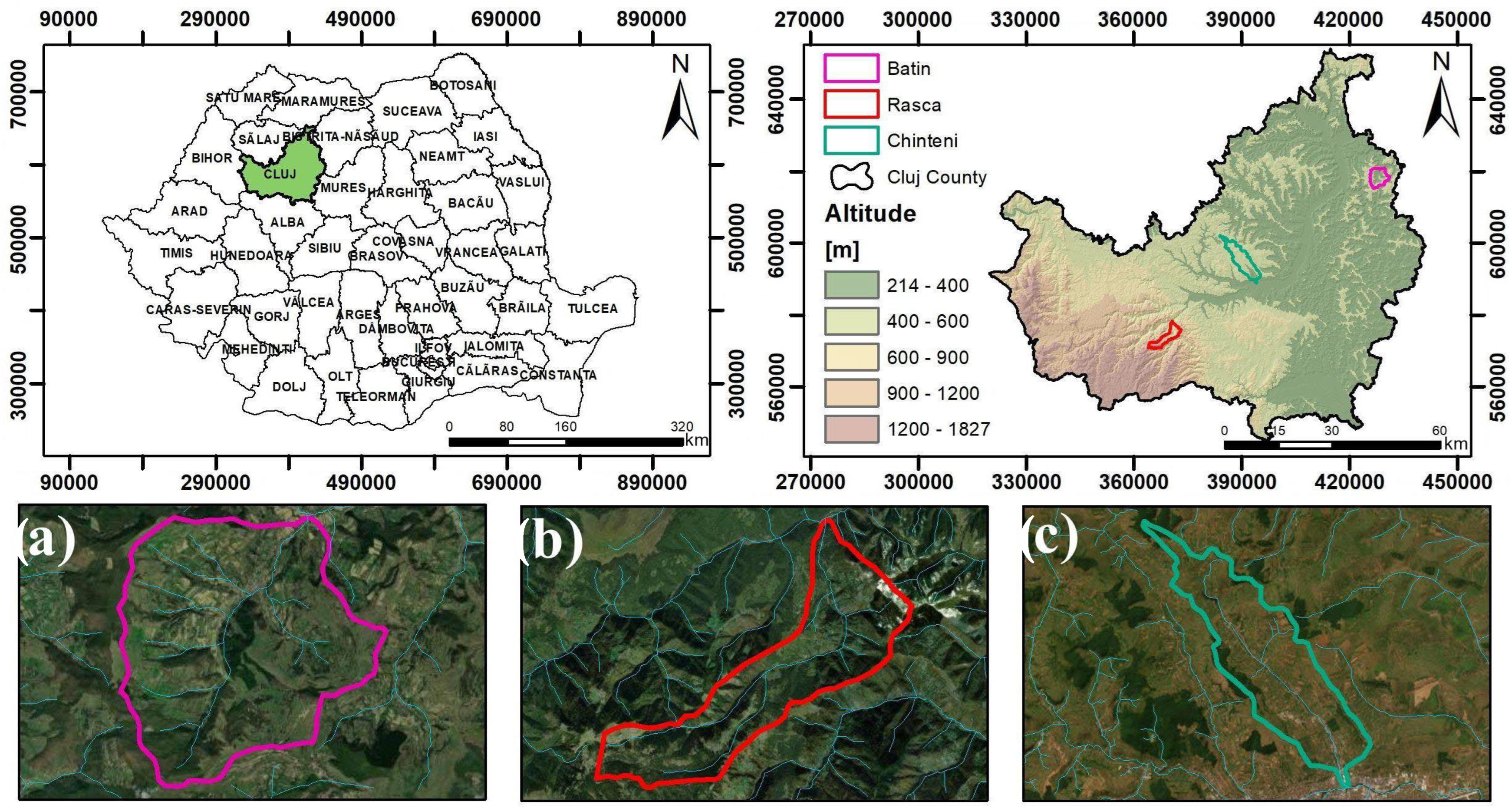

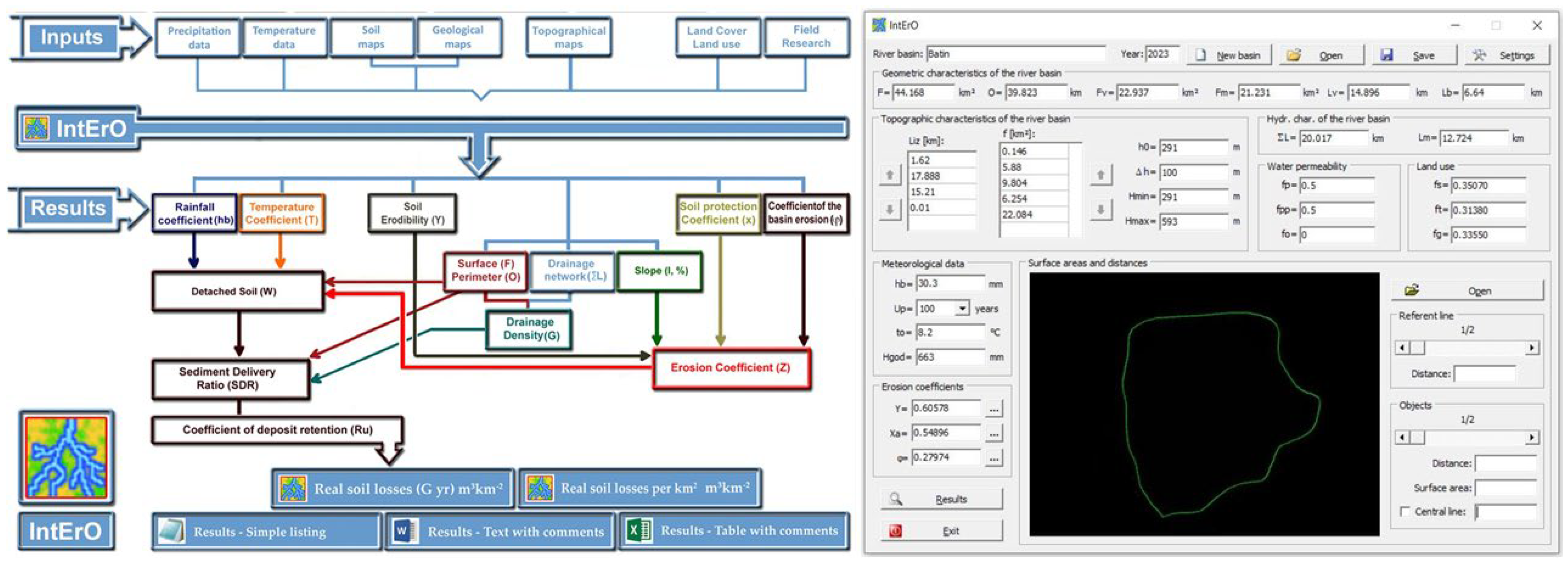
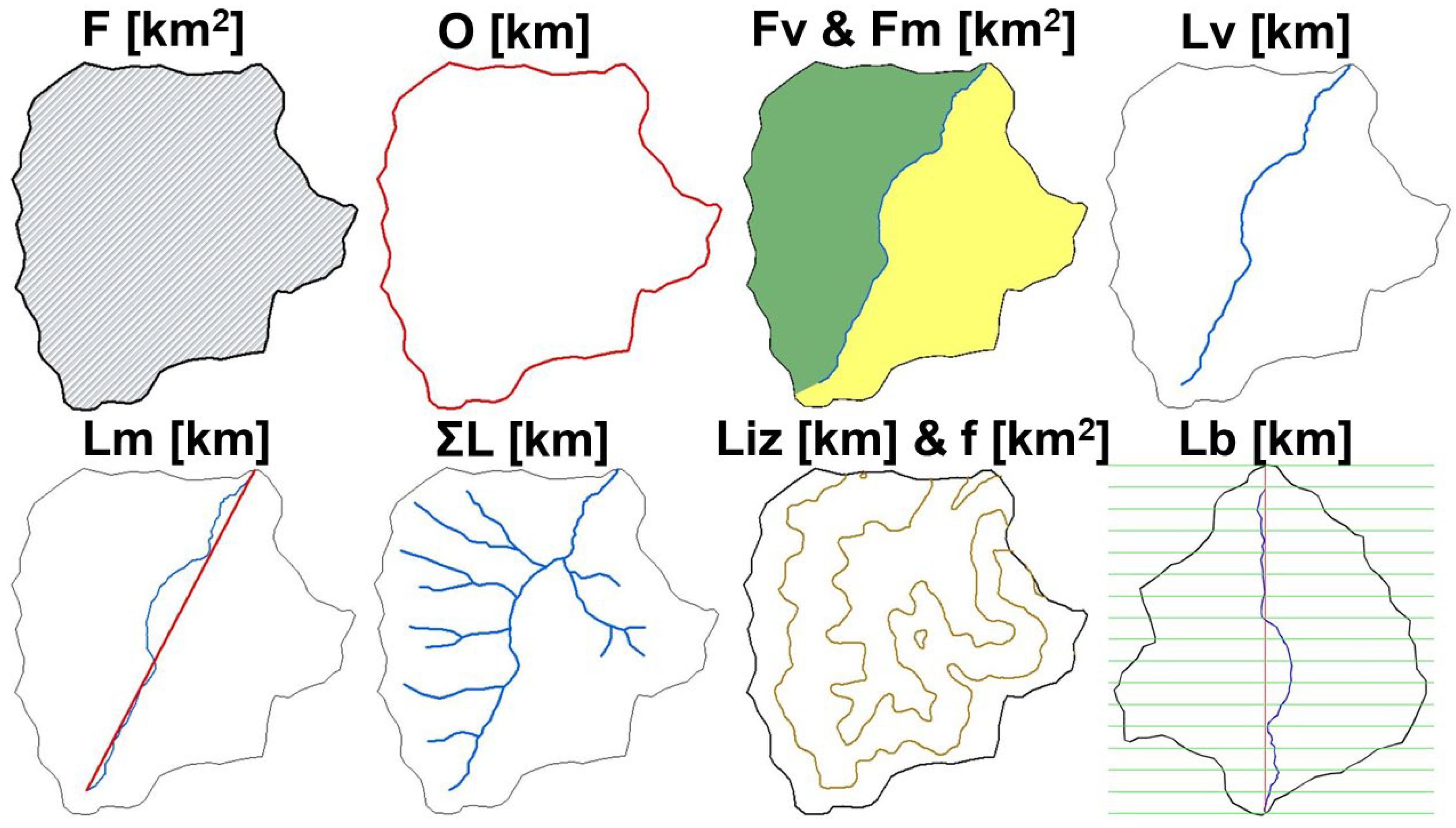
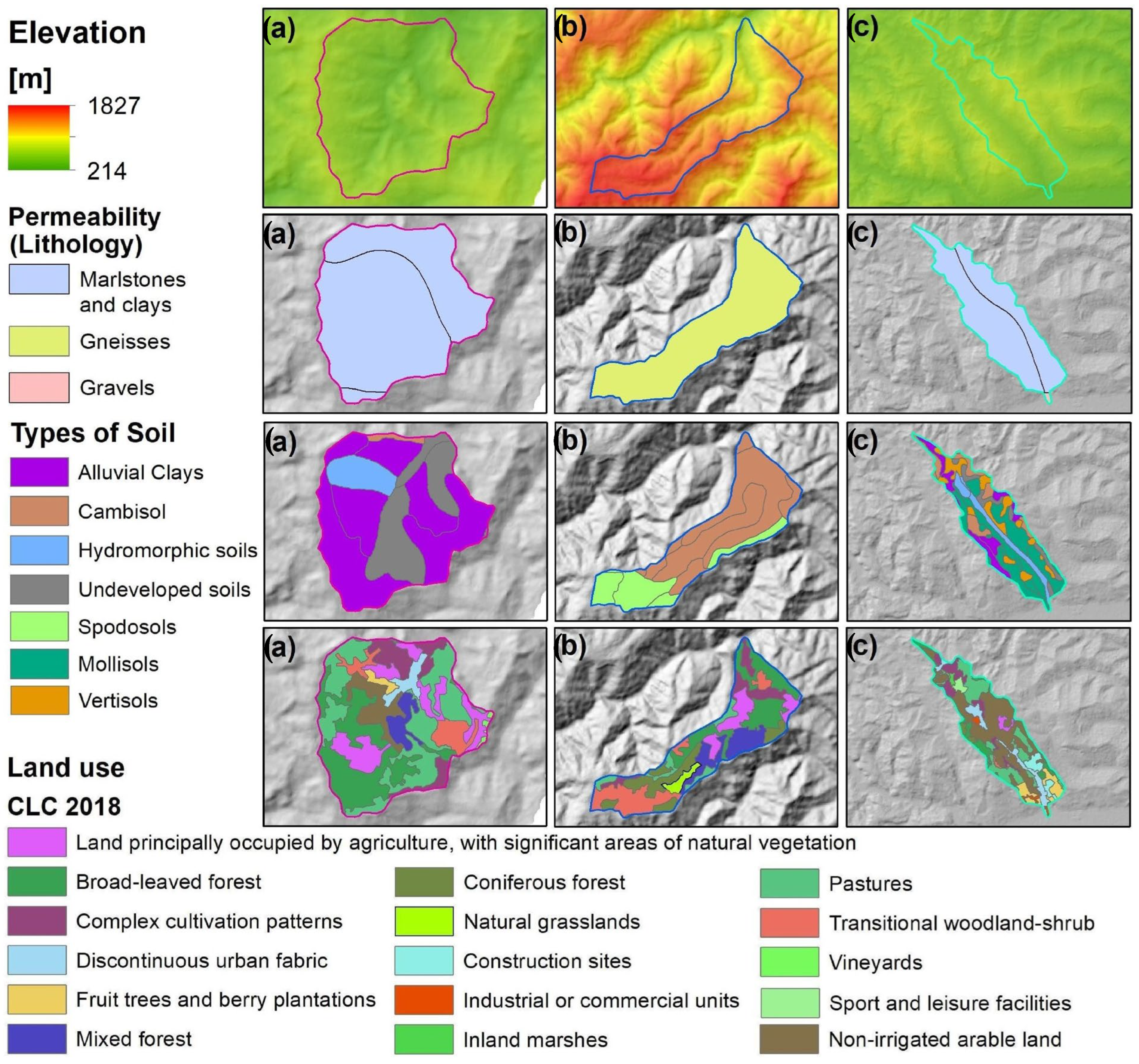
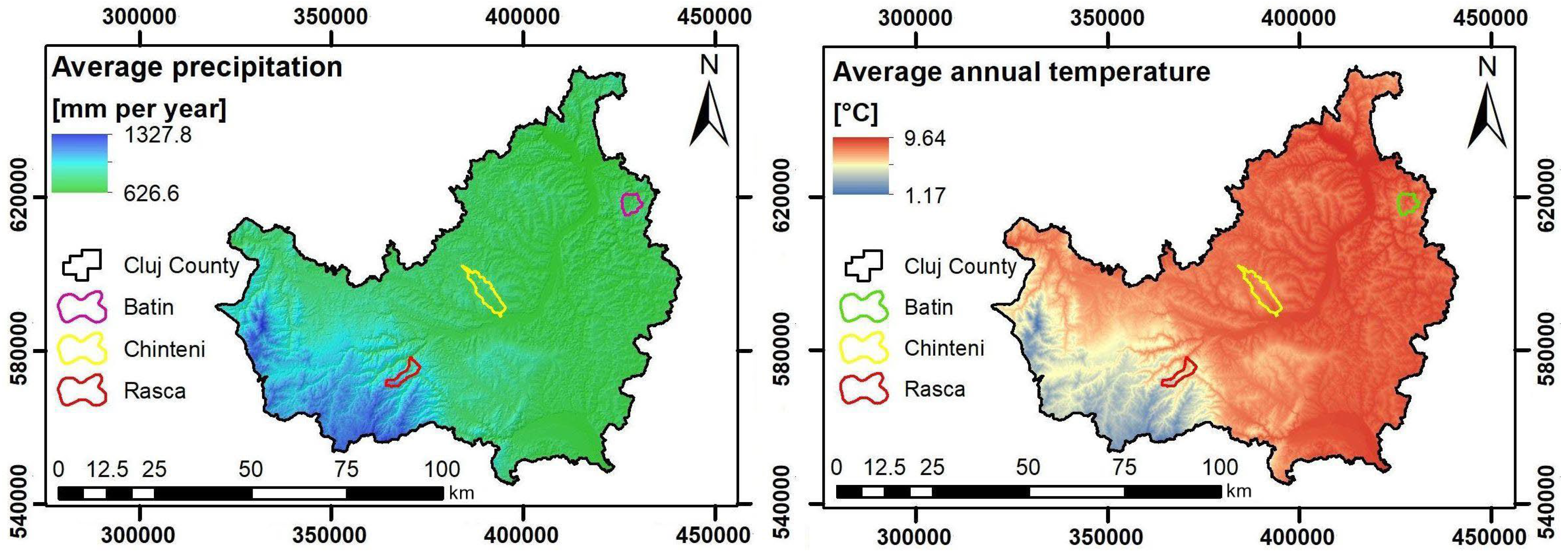
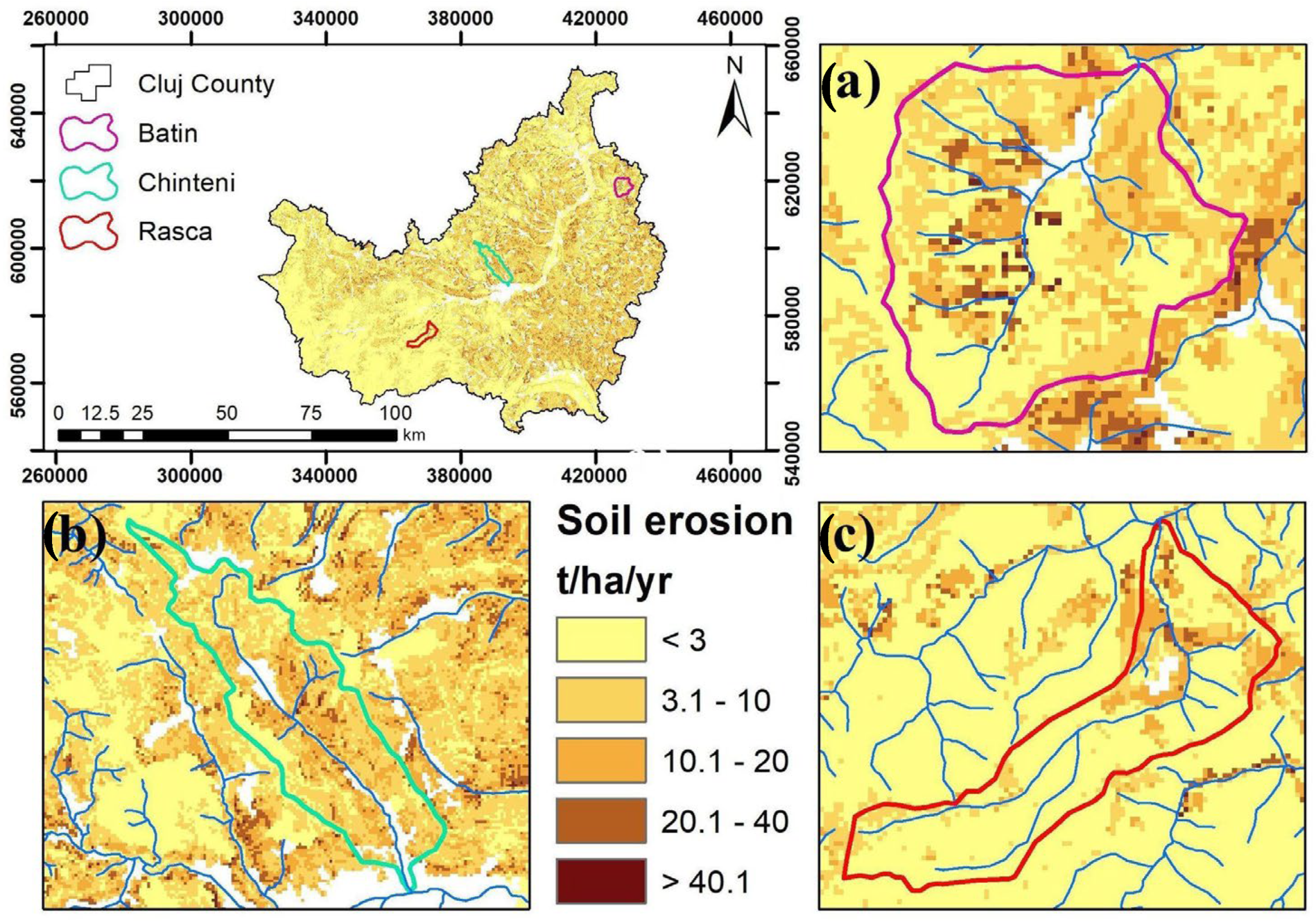
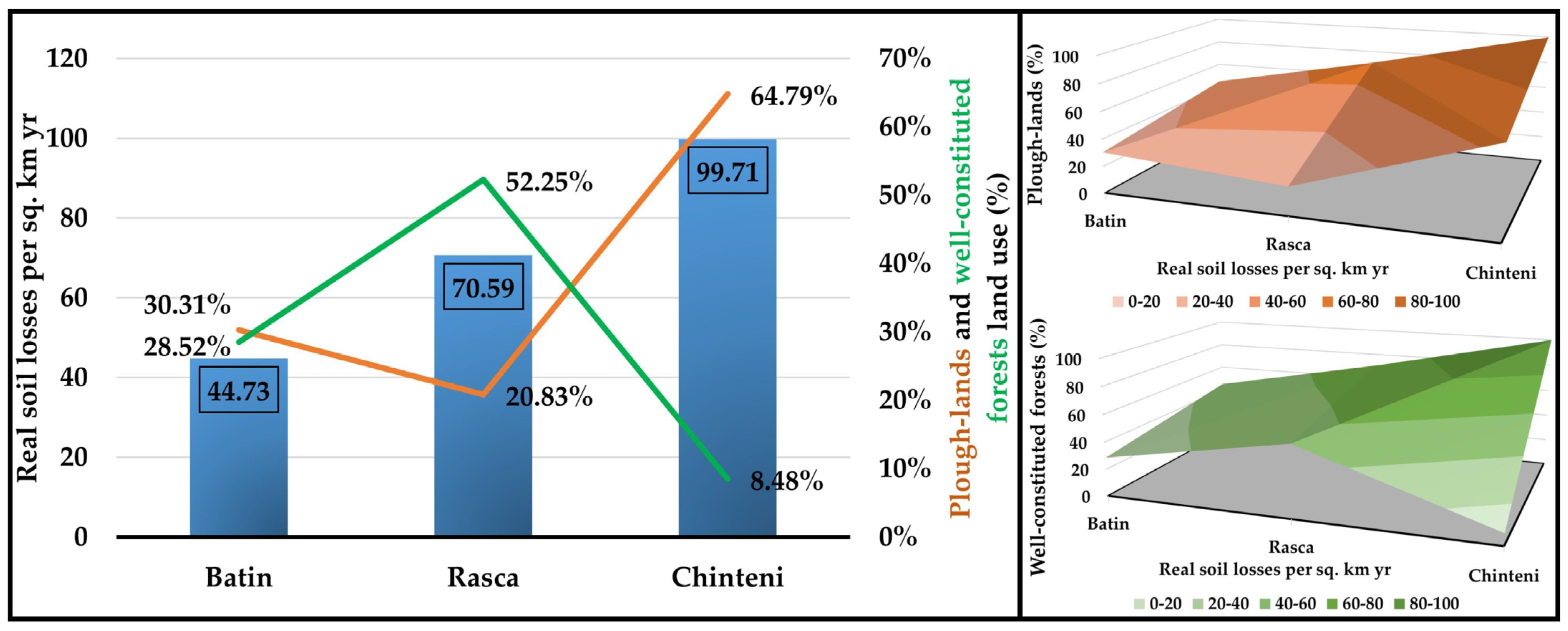
| Input Data | Abbr. | Unit | Batin | Rasca | Chinteni |
|---|---|---|---|---|---|
| River basin area | F | km2 | 21.29 | 20.47 | 44.17 |
| The length of the watershed | O | km | 19.06 | 26.48 | 39.82 |
| Natural length of the main watercourse | Lv | km | 6.41 | 11.55 | 14.9 |
| The shortest distance between the fountainhead and mouth | Lm | km | 5.81 | 8.88 | 12.72 |
| The total length of the main watercourse with tributaries of I and II class | ΣL | km | 21.92 | 22.11 | 20.02 |
| River basin length measured with a series of parallel lines | Lb | km | 6.64 | 10.93 | 17.37 |
| The area of the bigger river basin part | Fv | km2 | 10.76 | 14.98 | 22.94 |
| The area of the smaller river basin part | Fm | km2 | 10.54 | 5.49 | 21.23 |
| Altitude of the first contour line | h0 | m | 291 | 500 | 323 |
| Equidistance | Δh | m | 100 | 100 | 100 |
| The lowest river basin elevation | Hmin | m | 291 | 493 | 323 |
| The highest river basin elevation | Hmax | m | 593 | 1396 | 673 |
| A part of the river basin consisting of very permeable products from rocks (limestone, sand, gravel) | fp | 0.5 | 0 | 0.5 | |
| A part of the river basin area consisting of medium-permeable rocks (slates, marls, brownstone) | fpp | 0.5 | 0 | 0.5 | |
| A part of the river basin consisting of poor-water-permeability rocks (heavy clay, compact eruptive) | fo | 0 | 1 | 0 | |
| A part of the river basin under forests | fs | 0.35 | 0.7 | 0.08 | |
| A part of the river basin under grass, meadows, pastures and orchards | ft | 0.31 | 0.1 | 0.27 | |
| A part of the river basin under bare land, ploughland and ground without grass vegetation | fg | 0.34 | 0.21 | 0.65 | |
| The volume of the torrent rain | hb | mm | 29.1 | 37.8 | 30.3 |
| Average annual air temperature | t0 | °C | 8.1 | 4.7 | 8.4 |
| Average annual precipitation | Hgod | mm | 653 | 939 | 681 |
| Input Data | Abbr. | Value | Remarks | Percentage |
|---|---|---|---|---|
| Types of soil products and related types | Y | 0.6 | Well-structured Chernozems and alluvial, well-structured deposits | 64.74% |
| Brown forest soils and mountain soils | 35.26% | |||
| River-basin planning, coefficient of the river-basin planning | Xa | 0.55 | Ploughlands | 30.31% |
| Mountain pastures | 29.45% | |||
| Well-constituted forests | 28.52% | |||
| Degraded forests | 6.55% | |||
| Bare lands | 3.24% | |||
| Orchards and vineyards | 1.93% | |||
| Numeral equivalents of visible and clearly exposed erosion process | φ | 0.28 | Bare, compact igneous | 37.84% |
| Well-structured Chernozems and alluvial well-structured deposits | 18.92% | |||
| Solid and Schist limestone, Terra Rosa and Humic soil | 16.21% | |||
| Brown forest soils and mountain soils | 16.21% | |||
| Decomposed limestone and marls—cement rocks | 8.10% | |||
| Serpentines, red sandstone, flysch deposits | 2.72% |
| Input Data | Abbr. | Value | Remarks | Percentage |
|---|---|---|---|---|
| Types of soil products and related types | Y | 0.8 | Brown forest soils and mountain soils | 100% |
| River basin planning, coefficient of the river-basin planning | Xa | 0.38 | Well-constituted forests | 52.25% |
| Ploughlands | 20.83% | |||
| Degraded forests | 17.33% | |||
| Mountain pastures | 9.59% | |||
| Numeral equivalents of visible and clearly exposed erosion process | φ | 0.13 | Bare, compact igneous | 70.06% |
| Well-structured Chernozems and alluvial well-structured deposits | 20.30% | |||
| Brown forest soils and mountain soils | 9.64% |
| Input Data | Abbr. | Value | Remarks | Percentage |
|---|---|---|---|---|
| Types of soil products and related types | Y | 0.8 | Brown forest soils and mountain soils | 71% |
| Decomposed limestone and marls—cement rocks | 14.50% | |||
| Epieugleysol and marshlands | 14.50% | |||
| River basin planning, coefficient of the river-basin planning | Xa | 0.72 | Ploughlands | 64.79% |
| Meadows | 18.35% | |||
| Well-constituted forests | 8.48% | |||
| Orchards and vineyards | 8.37% | |||
| Numeral equivalents of visible and clearly exposed erosion process | φ | 0.32 | Well-structured Chernozems and alluvial well-structured deposits | 48.24% |
| Podzols and Parapodzols, decomposed Schist | 10.05% | |||
| Solid and Schist limestone, Terra Rosa and Humic soil | 10.05% | |||
| Brown forest soils and mountain soils | 10.05% | |||
| Serpentines, red sandstone, flysch deposits | 10.05% | |||
| Bare, compact igneous | 8.53% | |||
| Sand, gravel and incoherent soil | 1.01% | |||
| Saline soils | 1.01% | |||
| Decomposed limestone and marls—cement rocks | 1.01% |
| Results | Abbr. | Unit | Batin | Rasca | Chinteni |
|---|---|---|---|---|---|
| Coefficient of the river basin form | A | 0.58 | 0.45 | 0.52 | |
| Coefficient of the watershed development | m | 0.39 | 0.72 | 0.63 | |
| Average river basin width | B | km | 3.21 | 1.87 | 2.54 |
| (A)symmetry of the river basin | a | 0.02 | 0.93 | 0.08 | |
| Density of the river network of the basin | G | 1.03 | 1.08 | 0.45 | |
| Coefficient of the river basin tortuousness | K | 1.1 | 1.3 | 1.17 | |
| Average river basin altitude | Hsr | m | 441.77 | 959.6 | 441.5 |
| Average elevation difference of the river basin | D | m | 150.77 | 466.6 | 118.5 |
| Average river basin decline | Isr | % | 16.31 | 33.04 | 16.71 |
| The height of the local erosion base of the river basin | Hleb | m | 302 | 903 | 350 |
| Coefficient of the erosion energy of the river basin’s relief | Er | 44.75 | 135.13 | 43.22 | |
| Coefficient of the region’s permeability | S1 | 0.55 | 1 | 0.55 | |
| Coefficient of the vegetation cover | S2 | 0.8 | 0.7 | 0.91 | |
| Analytical presentation of the water retention in inflow | W | m | 0.4113 | 0.497 | 0.3992 |
| Energetic potential of water flow during torrent rains | 2 gDF½ | m km s | 250.96 | 432.93 | 320.45 |
| Maximal outflow from the river basin | Qmax | m3/s | 26.22 | 67.58 | 33.47 |
| Temperature coefficient of the region | T | 0.96 | 0.75 | 0.96 | |
| Coefficient of the river basin erosion | Z | 0.227 | 0.211 | 0.434 | |
| Production of erosion material in the river basin | W year | m3/yr | 4610.5 | 4429.8 | 25236.9 |
| Coefficient of the deposit retention | Ru | 0.207 | 0.326 | 0.175 | |
| Real soil losses | Ggod | m3/yr | 952.34 | 1445.12 | 4404.13 |
| Real soil losses per km2 | Ggod/km2 | m3/km2 yr | 44.73 | 70.59 | 99.71 |
Disclaimer/Publisher’s Note: The statements, opinions and data contained in all publications are solely those of the individual author(s) and contributor(s) and not of MDPI and/or the editor(s). MDPI and/or the editor(s) disclaim responsibility for any injury to people or property resulting from any ideas, methods, instructions or products referred to in the content. |
© 2023 by the authors. Licensee MDPI, Basel, Switzerland. This article is an open access article distributed under the terms and conditions of the Creative Commons Attribution (CC BY) license (https://creativecommons.org/licenses/by/4.0/).
Share and Cite
Sestras, P.; Mircea, S.; Cîmpeanu, S.M.; Teodorescu, R.; Roșca, S.; Bilașco, Ș.; Rusu, T.; Salagean, T.; Dragomir, L.O.; Marković, R.; et al. Soil Erosion Assessment Using the Intensity of Erosion and Outflow Model by Estimating Sediment Yield: Case Study in River Basins with Different Characteristics from Cluj County, Romania. Appl. Sci. 2023, 13, 9481. https://doi.org/10.3390/app13169481
Sestras P, Mircea S, Cîmpeanu SM, Teodorescu R, Roșca S, Bilașco Ș, Rusu T, Salagean T, Dragomir LO, Marković R, et al. Soil Erosion Assessment Using the Intensity of Erosion and Outflow Model by Estimating Sediment Yield: Case Study in River Basins with Different Characteristics from Cluj County, Romania. Applied Sciences. 2023; 13(16):9481. https://doi.org/10.3390/app13169481
Chicago/Turabian StyleSestras, Paul, Sevastel Mircea, Sorin M. Cîmpeanu, Razvan Teodorescu, Sanda Roșca, Ștefan Bilașco, Teodor Rusu, Tudor Salagean, Lucian Octavian Dragomir, Rastko Marković, and et al. 2023. "Soil Erosion Assessment Using the Intensity of Erosion and Outflow Model by Estimating Sediment Yield: Case Study in River Basins with Different Characteristics from Cluj County, Romania" Applied Sciences 13, no. 16: 9481. https://doi.org/10.3390/app13169481
APA StyleSestras, P., Mircea, S., Cîmpeanu, S. M., Teodorescu, R., Roșca, S., Bilașco, Ș., Rusu, T., Salagean, T., Dragomir, L. O., Marković, R., & Spalević, V. (2023). Soil Erosion Assessment Using the Intensity of Erosion and Outflow Model by Estimating Sediment Yield: Case Study in River Basins with Different Characteristics from Cluj County, Romania. Applied Sciences, 13(16), 9481. https://doi.org/10.3390/app13169481












